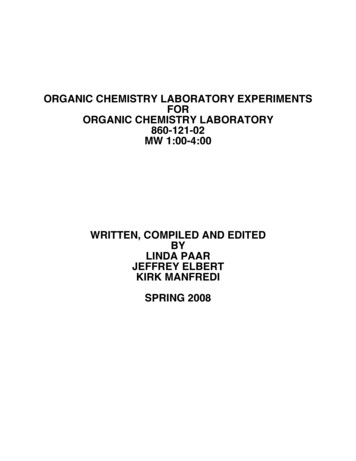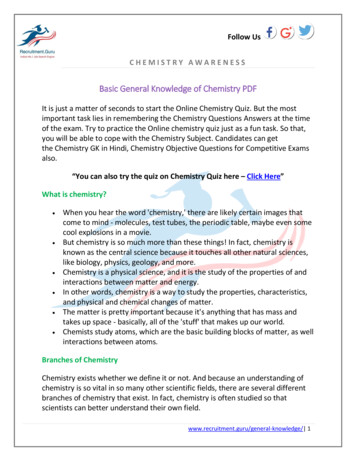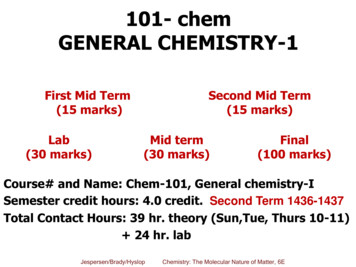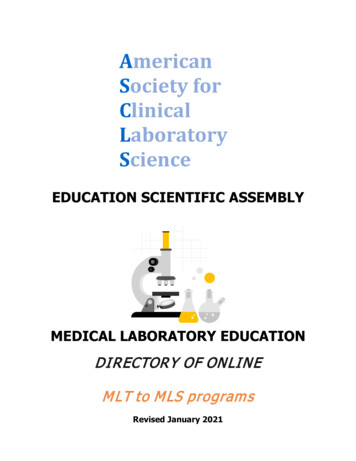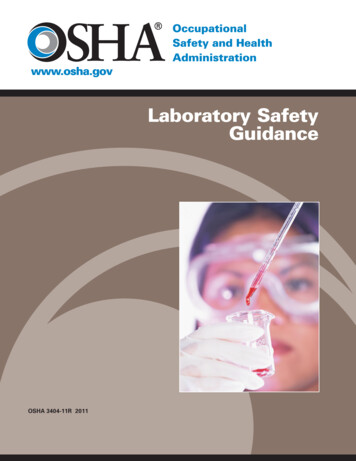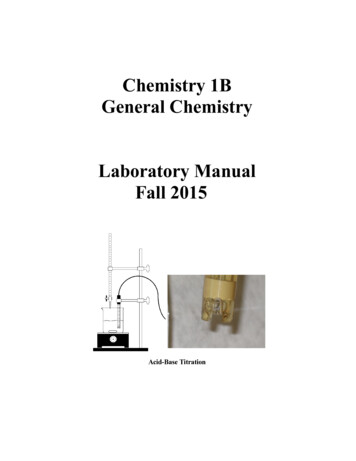
Transcription
Chemistry 1BGeneral ChemistryLaboratory ManualFall 2015Acid-Base Titration21
ions.2241
rationCurve.2332
California State University, SacramentoDepartment of ChemistryLast updated Spring 2013Laboratory PoliciesI. SAFETYa.b.c.d.e.f.g.h.i.j.k.l.Familiarize yourself with the location and use of all safety equipment and emergency exits inthe laboratory.Eating and drinking are not allowed in the laboratory at any time.Visitors are not allowed in the laboratory; leave the room for the duration of the visit.YOU MUST: Wear department approved safety goggles at all times when in lab. Shields arenever allowed! Wear shoes that completely cover your foot when in lab. Wear long pants or a skirt to the ankle and a lab coat when in lab. Wear nitrile gloves when working with chemicals. They must be removed prior toleaving the lab. (The stockroom will not provide gloves to students.)Long hair presents a serious fire hazard in the laboratory and must be properly restrained tominimize this hazard.Working in laboratories outside of the regularly scheduled periods is strongly discouraged.When such work is necessary, the written permission of both instructors is REQUIRED.Students in lower division laboratories are not to work in the laboratory unless an instructor isimmediately available (i.e. in the lab).Students in upper division laboratories are not to work in the laboratory unless an instructor isavailable in the vicinity (i.e. on the floor).Experiments using utilities such as gas, water, steam, heat, etc. are not to be left unattended. Ifit is necessary to use these utilities overnight, you must attach a card signed by your instructorto the apparatus and notify the Chemistry Service Center.Broken glassware must be placed in the "glass disposal boxes" provided.Unauthorized experimentation is prohibited!NO CHEMICALS, SUPPLIES, OR EQUIPMENT ARE TO BE REMOVED FROMTHE LABORATORY WITHOUT THE WRITTEN PERMISSION OF THEINSTRUCTOR AND THE SERVICE CENTER SUPERVISOR.II. PREGNANCY7.8.Women that are, or may become pregnant should carefully determine, upon consultation withyour personal physician or the Student Health Service Center, if it is advisable for them toparticipate in the laboratory program.If you are pregnant or are planning to become pregnant please inform your instructor.III. CHEMICALSa.b.c.d.e.Treat all chemicals as if they were hazardous.It is the student's responsibility to know the hazards of the chemicals used in the lab. Thisinformation is located in the chemical's MSDS (material safety data sheet), which can beobtained from http://rtk.complyplus.com/frame.asp.Never put chemical waste down drains or in the trash receptacles. Use appropriately labeledwaste containers.If a chemical waste container is almost full, immediately notify your instructor or the ServiceCenter; DO NOT OVERFLOW THE WASTE CONTAINER.Never put anything (i.e. spatulas, pipets, fingers, etc.) into a reagent bottle. Place any unusedreagents in the appropriate waste container; DO NOT return it to the bottle.3
f.g.h.i.Always return chemicals to their appropriate location.NEVER remove or borrow chemicals from another laboratory.If a required chemical is not available or needs to be refilled, notify your instructor.If chemicals are spilled, clean up the mess immediately. This especially includes spill on oraround balances and other equipment. If you are unsure of how to clean up a spill, seekassistance from your instructor or the Service Center.IV. EQUIPMENTa.b.c.d.e.DO NOT use any equipment until you have been properly instructed in its use.DO NOT move ANY piece of equipment without the permission of your instructor.DO NOT attempt to alter or repair any piece of equipment. If it is not in proper workingorder, inform your instructor.Clean all equipment immediately after you have finished using it, and if it was borrowed orchecked out, return it immediately.Because of the limited number of certain items. Special equipment issued by the ServiceCenters must be returned the same day or a fine of 5.00 will be assessed.V. SERVICE CENTERa.b.The Chemistry Service Centers WILL NOT issue chemicals or equipment (other than thosespecifically listed for an experiment, student locker or instructional laboratory) without theconsent of the instructor.The Service Center staff WILL NOT set-up labs after they have been taken down. The labset-ups are available for one week after a lab is completed, so plan your time appropriately. Itis best not to miss your regularly scheduled lab time.VI. EMERGENCIESa.In the event of ANY EMERGENCY, notify your instructor, and the Service Centerpersonnel immediately! DIAL 911 for emergencies, or 8-6851 to reach campus police on anycampus phone. Emergency phones are located in the lobbies of each floor in Sequoia Hall.**Failure to adhere to these laboratory safety policies will result in yourremoval from lab. The resulting missed lab can only be made up withinstructor approval within the standard makeup time line.4
Safety ContractI HAVE READ ALL OF THE ABOVE, AND I AGREE TO CONFORM TOITS CONTENTS.(This is for your records. You don’t need to turn this in.)Name:Course:Student ID:Section:Signature:Date:Lab Instructor:5Room:
Laboratory Regulations1. Safety is a prime requisite for laboratory work. Eye protection is required at all timesunless explicitly stated otherwise. You can not work without appropriate eye protection.A lab apron or coat will prove a good investment for protecting clothing. Learn thelocation of the safety equipment: fire extinguisher, safety shower, and eye wash fountain.Injuries/accidents should be immediately reported to your instructor.2. Lab work is to be done on an individual basis unless you are instructed otherwise.Prepare for lab by reading the experiment, preparing tables in your lab notebook (asneeded for each experiment) for collecting data, and completing the prelaboratoryassignment.3. Record your results immediately and directly into your notebook. Record observationsin detail. Do not write on scratch paper, only write in your laboratory notebook or inthe lab manual if indicated in the instructions.4. The most productive research demands original work, and this is strongly encouraged.However, for safety reasons this may be done only with the approval and supervision ofthe instructor. Unauthorized experiments are strictly forbidden.5. Students are allowed in the laboratories only during regularly scheduled class periods.Make-up labs must be approved by the lab instructor and must be completed within oneweek of the missed laboratory experiment. Approval is usually only given for medicalreasons (that is, if your doctor states you were sick, not if you had a routine appointment).You may not work in another lab without written permission from your laboratoryinstructor and the laboratory instructor in charge of the other section.6. Keep your lab area clean. Wipe up in a safe and approved manner spilled materials.Only soluble, harmless materials should be put in the sink, and these should be washeddown with plenty of water. Your instructor will advise you when it is permissible todispose of chemicals in the sink. Unless otherwise instructed insoluble or toxic materialsshould be put in the containers provided for chemical wastes in the hood. If in doubt, donot pour a substance down the drain; it will soon be carried to a water-treatment plant andpossibly pass through into a stream. Heed the warnings on the reagent bottles. If in doubtask your instructor.7. Balances and other delicate instruments require special care. Follow carefully thedirections for their use.6
Laboratory Notebook RequirementsYou must have a hard cover, bound notebook that was shown to you in lecture.The laboratory notebook will be collected periodically without prior announcement toensure you are practicing correct scientific procedures for collecting experimental data. Aportion of your laboratory grade will be based on your neatness, completeness, andattention to detail. Failure to bring your notebook to lab with you is not acceptable andyou may not be allowed to work.Table of Contents: You must leave several pages blank at the beginning of yournotebook for table of contents. That table will list each experiment that has been done andthe page number for which it can be found.Experimental Notes and Content: Title Page: Each experiment will start on a new, right hand side of page. It willinclude the name and number of the experiment. Objective: Following the cover page, will be a paragraph with the objective of theexperiment in your own words. You will most likely need to consult your textbook as well as your lab manual for additional information. Please cite anyreferences (see below for more information on this). Experimental Procedures: You will need to summarize the procedures for theexperiment. You do not need to rewrite them, but summarize them in a way thatyou could get through the experiment without your lab manual. This will requirethat you read it in depth. Data Collection Tables: All data will be signed by your instructor. No signatureon data will result in 0 credit. You will need to consult your lab manual for anexample of the table you will need to construct in your notebook. This is to bedone AHEAD OF TIME. Use a ruler or straight edge to make your tables neat andlegible for anyone who would read it (including you!)All entries in the notebook must be in ink. Record data as you gather themdirectly into the notebook. Never record data on loose slips of paper (e.g. papertowels, scrap paper, etc.) for later transfer to the notebook. Should a correction benecessary, draw a single, light line through the erroneous value and enter thecorrect value (example.) The original value must remain legible (you may laterdecide to use it). Wherever possible, tables of data are preferred to isolatevalues; in either case, all values must be clearly labeled so that your notebook iscomprehensible to someone with training comparable to you own. Data should beneatly organized. Record the measurements at the time you make them. Ifrepeated trials are made, list repetitive measurements in parallel columns. Forexample,Title of Table (Descriptive)Description of what is being recorded Trial 1Trial 2Trial 3(units)(units)(units)7
Sample calculations: Show sample calculations below data table. Be sure toinclude units. Units are shown in the columns with their labels. Don’t forget yourunits when showing an example calculation. Since many calculations arerepetitive, you can continue to work them out on a separate piece of white paper toinclude with your report.Observations: These are a crucial part of your scientific endeavors. Dependingon the experiment, some observations can be incorporated into the data table.Other experiments will require a separate section. All experiments haveobservations, your attention to detail will not only lead to greater success in thelaboratory, it will help prepare you for exams and quizzes as well.References: if you use a particular reference book or website for additionalinformation, please reference it here. It is perfectly acceptable to use referencematerial other than that of your textbook and lab manual. It is not onlyacademically dishonest (and often times illegal) to quote a book or website withoutmention of the origin!8
Prelaboratory AssignmentPrelab assignments are always due at the beginning of the lab period. When you enter thelab, you should tear them out of your lab manual and stack them on the instructor’s bench.Failure to complete the prelab assignment will result in your immediate dismissal fromlab. In other words, you will not be allowed to perform the experiment nor will you begiven any additional time to make up that experiment. This means that if the class isperforming an experiment that is given one day to complete, you will receive a 0 for thatexperiment!Each prelab assignment is found at the end of the experiment (with the exception ofExperiment 1). It consists of a few short answers and/or calculations pertaining to theexperiment. Once you have thoroughly read the experiment and completed your notebookrequirements, then you should work on the prelab assignment.Bring your laboratory notebook and laboratory syllabus to each class period unlessotherwise stated.9
How to Write a Lab Report for Chem 1BEach experiment that you perform will have its own list of information that needs to beorganized into the report you will turn in to your laboratory instructor. This information isfound at the end of each experiment in the section labeled Laboratory Report. A generaloutline of the required sections in your report is shown below. Make sure to number eachpage of your report once it is assembled.Title Page #Your nameExperiment #DatePartner’s nameSection #(unknown #)#PrelabSigned byinstructor.Torn out of labmanual.Data Pages #From labnotebook thathave been signedby lab instructor#ResultsTables w/Results,Hand writtencalcs underTablesTYPEDTYPEDQuestions, #Error AnalysisAndConclusionsTYPEDPhotocopy Title page: Your title page is always to be typed. Any additional information listedin the Laboratory Report section for Title Page should also be included. Forexample, your partner’s name (if any; clearly identified! Ex. Partner: Katie Smith),the identity of an unknown along with the unknown number if applicable. Title pageshould always include experiment number, title, your name, section number, anddate. Each experiment will require slightly different information on the cover page(see Laboratory Report section of each experiment), but it will always includeexperiment number, title, your name, section number and date. Pre-Lab Assignment: Always include your prelab assignment. You can put yourprelab with all corrections made at the beginning of the report. Corrections should bemade on a separate white piece of paper if needed. As always, please make thosecorrections easy to read and reference where those corrections can be found (bypage # in report) if they are placed elsewhere on a separate page. Data Pages: Photocopy the data pages from your notebook and attach them to yourreport. The data pages must clearly show your name, page number, the data, andyour instructor’s signature. Results: Any tables that are mentioned in the Laboratory Report section should becomputer processed to the extent listed in the Laboratory Report section. Nomistakes! No hand-written values or information in the Tables. There may be anexample shown of how that table should look, if not you should create one of yourown to display the values or data that is requested. Generally speaking, re-typing ofdata collected in lab is not necessary unless specifically requested in the LaboratoryReport section. Tables should be formatted in a way that the data/values are clearlypresented. When typing formulas, you will need to use proper superscripts andsubscripts. Your word processor will have a tutorial on this. The appendix section10
of this lab manual has a general tutorial for an older version of Microsoft Word. Thismay mean that you have to print them in landscape orientation rather than portrait. Itdepends on the size of the table, use your judgment and resize columns as necessary.The sample tables below show you an acceptable table with proper sizing and superand subscripts. The second table shows improper column sizing and font formatting.Acceptable:Ka (exp) H3PO41.79 x 10-5Not Acceptable: Ka (exp)H3PO41.79 x 10 5Your tables should not be split in half like the example below. Reformat your page size(margins) so that it all appears on one page.If a table is too large to appear on one page, the column headings should be repeated onthe second page where the table continues. An unacceptable table is shown below andcontinues onto the next page without proper column headings:Acid pH obspH theo% DissKa expKa ---------- PAGE BREAK Cl#.###.#####-----largeNH4Cl #.###.###.###.###.##Sample Calculations underneath Table: (hand write)----#.##------#.##------#.## Calculations: Many tables that you prepare will be filled with values that you havecalculated. See hypothetical table above. You do not need to type calculations.Neatly hand writing that calculation under the table is sufficient. Remember that ifwe can’t read it, we can’t grade it. The calculations should always be shown underthe table that displays those values. If those calculations cannot be written underthe table, clearly list (by giving the page number) where those calculations canbe found and number the pages of your report (by hand) so that finding them isclearly mapped out. You are required to turn in all your calculations so that simplemath mistakes can be tracked easily and fewer points taken off for those mistakes. Questions and Error Analysis: Many experiments you perform this semester willinclude a few questions to be answered. These questions are found in the LaboratoryReport section and can be torn out of the manual and attached to your report. Makesure you write in complete sentences but they can be short and to the point. Hint:11
students often misread or misunderstand the question being asked. Always re-readwhat the question is asking you to answer. A common, yet unacceptable answer isshown on the following page.Will the calculated value of K be too high or too low if:1) the original solution was supersaturated?Student answer: if the solution was supersaturated then that means there was toomuch of the solid in the solution. Our calculated value of K will be off a lot becausewe can’t account for this amount.Student did not answer the question that was asked. “Our calculations will be off” isobvious and true for all error analyses yet it does not answer the question asked.Make sure you answer the question you are asked. Conclusions: Some experiments ask you to reflect and make conclusions at the endabout what you have done. Conclusions should be typed. A one sentence conclusionis never sufficient however a full page is rarely needed either. Generally a paragraphis all that is needed to accurately describe your conclusions. The Laboratory Reportsection will indicate whether or not you need a conclusion statement with yourreport. Thank you: We know how hard you work in this class, thank you for all your hardwork! J 12
Nomenclature of Acids, Bases and Salts Review:You are expected to know Nomenclature when entering 1BI. Objective: To review the rules for naming common inorganic acids, bases and salt.II. Principles: The rules of nomenclature are the rules published by the InternationalUnion of Pure and Applied Chemistry (IUPAC). Compounds are still named by theserules; however, others are still named by their historical names (common names). Therules in this section are used by chemists in naming acids, bases and simple salts derivedfrom acids and bases.I. Binary Compounds.A binary compound contains only two elements. In general, a binary compound isnamed by first stating the name of the more electropositive element, followed by the nameof the more electronegative element (usually a nonmetal), changing its stem to -ide.A. Acids: Binary acids in aqueous solution are named differently than in the gas phase.Refer to the examples below to see the differences.Examples:Aqueous SolutionHClhydrochloric acidHBrhydrobromic acidH2 Shydrosulfuric acidHCNhydrocyanic acidHIhydroiodic acidNote: CN- is treated as if it were a single element.Gas Phasehydrogen chloridehydrogen bromidehydrogen sulfidehydrogen cyanidehydrogen iodideB. Bases: The OH- ion is considered as a single element, therefore all compoundscontaining OH- are called hydroxides.Example: Ca(OH)2NaOHNH3calcium hydroxidesodium hydroxideammonia (common name)C. Salts: If the metallic element has more than one valence, the oxidation number isdesignated by a Roman numeral: Fe(II) and Fe(III), for example. Group IA and IIAcations have only one valence; thus there is no need for a Roman numeral.D. Binary compounds containing two nonmetallic elements are usually named in thefollowing manner:The number of atoms each element in a chemical formula are indicated by numericalprefixes: mono (1), di (2), tri (3), tetra (4), penta (5), hexa (6), hepta (7), octa (8).Examples: N2Odinitrogen monoxideP2 S5diphosphorous pentasulfide.13
II. Ternary CompoundsTernary compounds contain three elements.A. Acids: Most common ternary acids (also called oxyacids) contain hydrogen, oxygen,and another element.1. The most common acid consisting of this combination of elements is named byadding -ic to the nonmetallic element.Examples: H2SO4 sulfuric acidH3BO3 boric acidHClO3 chloric acidH2CO3 carbonic acidHNO3 nitric acidH3PO4 phosphoric acid2. For an acid containing one less oxygen atom than that in (1), the suffix -ic changesfrom -ic to -ous.Examples: H2SO3 sulfurous acidHClO2 chlorous acidHNO2 nitrous acidH3PO3 phosphorous acid3. For acids containing one less oxygen atom than in (2), the suffix remains the samebut the prefix hypo- is added.Example: HClO hypochlorous acid4. For acids containing one more oxygen atom than the most common acid with asuffix of –ic is named by adding the prefix per- to the name.Example: HClO4 perchloric acid5. A table has been prepared for you on the following page to help summarize thenomenclature rules for naming oxy-acids and oxy-anions. This table is not acomplete listing of all ternary compounds but it is a more visual summary of thesetypes of compounds and their corresponding names. The authors of this labmanual urge you to use it and expand it as necessary for your own needs.14
PO33PO43-Notice the shaded row. All of those anions are named using the –ate suffix only. Ifyou memorize those anions only, and know the nomenclature rules when oxygens areadded or removed, you will automatically know how to name them correctly withoutactually having to memorize them. A few examples are shown below.AnionNO2NO3ClO3ClOCO32SO32-NameNitrite ionNitrate ionChlorate ionHypochlorite ionCarbonate ionSulfite O3H2SO3NameNitrous acidNitric acidChloric acidHypochlorous acidCarbonic acidSulfurous acidRemember: Learn the “-ates” for both categories (how many oxygens and thecharge of the ion) and you will be able to name all the rest by only having to knowthe prefix and suffix.15
6. There are six strong acids that you need to memorize. This list can also befound in your current text book as well. There is an additional strong acid oftentaught in Chem 1A, HClO3, chloric acid. Assume all other acids are weak acids.Strong acidHClHBrHIHNO3HClO4H2SO4NameHydrochloric acidHydrobromic acidHydroiodic acidNitric acidPerchloric acidSulfuric acidB. Salts:1. Anions of salts derived from the ic acids, with all hydrogens removed, are namedby changing ic to ate.Example: H2SO4 sulfuric acidNa2SO4 sodium sulfate.2. Anions of salts formed from acids containing an ous suffix are named by changingous to ite.Example: HClO2 chlorous acidNaClO2 sodium chlorite3. Anions of salts of hypo .ous acids retain the prefix hypo but ous is changed to ite.Example: HClO hypochlorous acid NaClO sodium hypochorite4. Anions of salts from a per.ic acid retain the prefix per and ate is substituted for ic.Example: HClO4 perchloric acidKClO4 potassium perchlorate.5. Some salts contains anions that contain hydrogen, e.g. KHS and NaHSO4. Theseanions are derived from acids which are not completely neutralized. The name ofthe anion is formed by adding the word “hydrogen” with a numerical prefix wherenecessary, to indicate the number of replaceable hydrogens. The word hydrogenoccurs first.Examples: NaHSO4Al(HSO4)3NaH2PO4Ca(H2PO4)2sodium hydrogen sulfatealuminum hydrogen sulfatesodium dihydrogen phosphatecalcium dihydrogen phosphateThe prefix “mono” is not necessary to indicate one hydrogen.Appendix 1 has many practice problems for you to work.16
Experiment 1Chemical Reactions and Net Ionic EquationsI. Objective:To predict the products of some displacement reactions and write net ionic equations.II. Chemical Principles:A. Reaction Types.Chemical reactions can be classified into several different categories. The commonclassifications are as follows:Note: For ease of production in this syllabus (aq) has been eliminated from all equationswhile (s), (l) and (g) have been used to represent phases. When you write chemicalreactions in your lab reports you must show all phases including (aq).1. Combination. This reaction type involves the combining of elements and/or compounds to form a newcompound.element2 Mg(s) element O2(g) compound2 MgO(s)elementO2(g) compound compound2 NO(g) 2 NO2(g)compoundNH3(g) compound compoundHBr(g) NH4Br(s)2. Decomposition. This reaction type involves the splitting apart of a single compound to form newcompounds or elements.compound2 KClO3(s) new compound and/or elements2 KCl(s) 3 O2(g)CaCO3(s) CaO(s) CO2(g)3. Single Replacement. This reactio
Chemistry 1B General Chemistry Laboratory Manual Fall 2015 Acid-Base Titration. 1 Table&of&Contents& . book as well as your lab manual for additional information. Please cite



